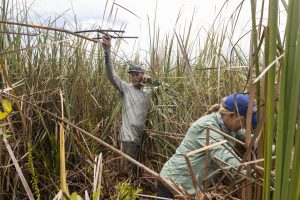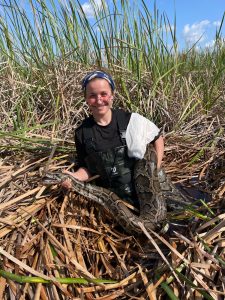Highlights:
- Burmese python breeding season is in full swing in the Florida Everglades.
- For a team of scientists at the University of Florida Institute of Food and Agricultural Sciences (UF/IFAS) and U.S. Geological Survey (USGS), this means intensifying efforts in a chest-deep aquatic Everglades environment.
A team of UF/IFAS and USGS scientists are on the search for pythons, employing new tactics and equipment in the next phase of a large-scale python telemetry scout project launched last year.
Video credit: Alex Grimsley.
The goal of the project is to study Burmese python biology and movement patterns as they leverage state-of-the-art radio telemetry technology during the species’ mating and breeding season to locate and remove pythons within a densely aquatic site in the eastern Everglades. A site where there is an abundance of pythons and conditions that make it easy for them to camouflage into the tall sawgrass and slip away into the water within seconds.
“We have intensified efforts by tracking 14 pythons — up from eight — year-round to increase our understanding of how pythons are moving and using resources in a predominately aquatic habitat within the Everglades,” said Melissa Miller, project lead and research assistant scientist specializing in invasion ecology at the UF/IFAS Fort Lauderdale Research and Education Center. “These data can improve our understanding of their use of space and help us get better at detecting and removing pythons.”

During the breeding season, when multiple male pythons aggregate around a reproductive female vying for a chance to mate, the team can capture and remove any pythons that are attracted to the team’s tagged pythons. These non-tagged pythons are referred to as “associate snakes.”
“We have made significant headway leveraging radio telemetry technology and are looking forward to removing more associate pythons this time around while further studying python movement and behavior in this challenging aquatic environment,” she said.
This year, the team’s python target location complicates and yet enhances the research into python behavior.
Working with Miller is Brandon Welty, a UF/IFAS graduate student at the department of wildlife ecology and conservation (WEC), who has developed innovative techniques to capturing the associate snakes. The study site, encompassed with dense vegetation, is seasonally inundated with water with large expanses of habitat that contain water year-round.
“We only get a brief opportunity to catch associate pythons when they are in these aquatic environments,” said Welty. “If the snake retreats into the water, it becomes almost impossible to locate. Therefore, we occasionally have to exit the airboat to ensure a successful capture.”
The team continues to collaborate with a veterinarian to surgically implant radio transmitters into additional scout pythons, enabling tracking for a comprehensive study of their movement patterns, behavior, habitat utilization and what are known as life history traits.
Life history traits of interest may include data on vitals such as survivorship, timing of reproductive events, clutch size, growth rate and more. These characteristics are inheritable, interconnected and can be influenced by natural selection.
The UF/IFAS and USGS Fort Collins Science Center researchers, along with Danny Haro, a UF/IFAS doctoral student, and Christina Romagosa, an associate professor and project collaborator, at WEC in Gainesville, are using data collected during tracking events to inform statistical removal models.
“We anticipate data collected during python tracking will increase the robustness of the removal model, ultimately allowing us to estimate key population parameters for pythons such as detection and abundance” said Amy Yackel Adams, a USGS research ecologist.

Haro’s research may allow scientists to estimate the number of pythons at this study site, a much-needed endeavor as no tractable estimate of python abundance is known and prevents assessment of removal efforts.
Additionally, staff survey the vicinity during breeding season to identify associate snakes, facilitating the removal of non-tagged pythons from the wild.
“We are learning why there is a knowledge gap concerning how pythons are using aquatic habitats as it is not easy to track pythons in high water and dense vegetation,” said Miller. “Tracking often requires airboats and aerial flights to locate the snakes.”
While tracking pythons in more aquatic environments is challenging, the team is collecting critical data that will improve scientists’ understanding of how pythons utilize varying landscapes in South Florida.
On tap for this season is to incorporate a drone equipped with radiotelemetry tracking software to increase data collection while reducing resources needed to track pythons.
Scientists hope the breeding season will promote additional capture and removal of adult reproductive pythons, particularly large females, from remote interior locations of the Everglades. Adult female pythons can produce over 100 eggs in a clutch making these females a target for removal.
“Python telemetry scout programs have repeatedly shown to be an effective method for detecting and removing pythons from interior landscapes,” Miller said. “This contrasts with the majority of removal efforts, which are limited to capturing pythons along roadways and levees that can be easily accessed.”
This large-scale python telemetry scout program is led by UF/IFAS scientists in close collaboration with Amy Yackel Adams, Mark Sandfoss and Amanda Kissel, scientists with the USGS Fort Collins Science Center.
“A benefit to our collaborative study—in addition to increased overall science capacity—is that we get to simultaneously remove pythons during the breeding season while we track tagged pythons year-round to learn more about their ecology,” said Miller. “These efforts will increase our ability to detect and remove pythons and allow us to assess the efficacy of removal efforts.”
Funding for this long-term research project is provided by the South Florida Water Management District (SFWMD) and the Florida Fish and Wildlife Conservation Commission (FWC).
“Controlling invasive species, such as the Burmese python, continues to be a high priority for the FWC,” said McKayla Spencer, a nonnative fish and wildlife program coordinator with FWC. “Supporting this scout snake project not only helps us remove additional pythons across the difficult-to-access, semi-aquatic Everglades landscape, but also increases our knowledge of python behavior and life history — information that can be used to better inform removal efforts in the future.”
###
By Lourdes Mederos, rodriguezl@ufl.edu
Para accesar este contenido en español, por favor utilice este enlace.
ABOUT UF/IFAS
The mission of the University of Florida Institute of Food and Agricultural Sciences (UF/IFAS) is to develop knowledge relevant to agricultural, human and natural resources and to make that knowledge available to sustain and enhance the quality of human life. With more than a dozen research facilities, 67 county Extension offices, and award-winning students and faculty in the UF College of Agricultural and Life Sciences, UF/IFAS brings science-based solutions to the state’s agricultural and natural resources industries, and all Florida residents.
 2
2
